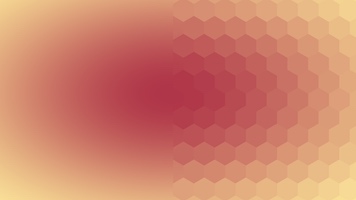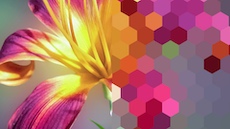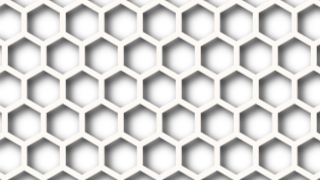| Properties | ||
| Offset | The offset of the hexagon pattern relative to the layer position. Default: 0, 0 |
|
| Size | The size of the pattern, based on the height of the layer (at a size of 100, approximately one hexagon fills the layer vertically) Range: 0.5 to 200; Default: 10 |
|
| Stretch | Scales the hexagon pattern vertically, independent of the overall size, which can be used to stretch or squash the hexagons in the pattern. Range: 0.01 to 10; Default: 1 |
|
| Coloring | Controls how hexagons in the pattern are colored.
|
|
| Color 1 | The first color, used in every coloring mode except Layer. Default: |
|
| Color 2 | The second color, used in every coloring mode except Layer and Solid. Default: |
|
| Color 3 | The third color, used in Tricolor, Cubes, Triangles and Pentagonal. Default: |
|
| Alpha | Controls the opacity of the hexagonal array pattern. Range: 0% to 100%; Default: 100% |
|
| Blending Mode | Controls how the hexagonal array pattern is blended with the layer.
|
|
| Scale Using Layer Alpha | If this is turned on, each hexagon will be scaled based on the alpha value of the layer at the pixel at the center of the hexagon. For example, if the pixel under the hexagon is only 50% opaque, the hexagon will be only 50% of the size defined by Size. Default: off |
|
| Copy Layer Alpha | If this is turned on, each hexagon will become partly transparent based on the alpha value of the layer at the pixel at the center of the hexagon (technically, the alpha value of the pixel is multiplied with the alpha value of Color 1, Color 2 or Color 3 respectively). If this is turned off, hexagons are rendered fully opaque (or with whatever transparency is specified by the alpha of Color 1, Color 2 or Color 3) Default: off |
|
| Line Width | The width of the lines between hexagons in the array, as a ratio of the hexagon size. At 0, there will be no lines between the hexagons. At 1, the lines will be just wide enough to make all of the hexagons disappear. Range: 0 to 1; Default: 0.1 |
|
| Feather | Softens the gaps between the hexagons. Range: 0 to 1; Default: 0.05 |
|
| Angle | The angle of the pattern relative to the layer. Range: 0º to 3600º; Default: 0º |
|
| Screen Space | If this is turned on, Offset, /Size, Stretch, and Angle become relative to the screen instead of relative to the layer. Default: off |
|
Usage
There are many different ways to use Hexagon Array, each involving different combinations of settings.
Basic
For a standard hexagon pattern overlay, just apply the effect to any layer, set Size, Line Width, and Offset as desired, then choose any Coloring other than Layer and adjust color and blending mode to taste.
Custom Coloring / Hexagon Mosaic
For a custom coloring, fill the layer with the colors you want to use first, then set Coloring to Layer. For example, you can fill the layer with a gradient. Here, a radial gradient was used, Coloring was set to Layer and Line Width was set to 0.

This exact same process can be used with a photo layer to create a hexagonal mosaic.

Scaling Individual Hexagons
To scale individual hexagons, make the layer partially transparent (an easy with is to use the Wipe effect with a lot of feather) and then apply Hexagon Array with Blending Mode set to Overflow and turn on Scale Using Layer Alpha.

This was made with the above technique, but with the additional step of setting Line Width to zero and Coloring to Layer.
Hexagon Lattice
To make a hexagonal lattice, simply start with a solid color layer, apply Hexagon Array and then set Blending Mode to Punch Out.

Here, to emphasize the effect, we also applied a shadow in Border & Shadow.
Known Issues
There is a known issue with this effect where Copy Layer Alpha only works properly when Blending Mode is set to Overflow and Coloring is set to something other than Layer. We plan to address this issue in a future update, so recommend avoiding combinations that don't work correctly as they may change in the future.
Use Cases
- Hexagon Wipe Transition: Use the technique described above in Scaling Individual Hexagons but animate the Wipe effect's Start property. Then use the layer as a mask for a photo or video.
- Photo Styling: Apply Hexagon Array to a photo or video, set Coloring to Layer and Blending Mode to Screen.

See Also
- Hexagon Tiling
- Hexagon Tile Shift
- Hexagon Tile Rotate
